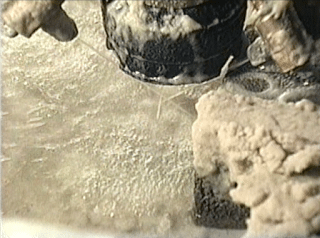As mentioned in that earlier post the central tube connects to a vacuum line which removes the loosened debris and water. An earlier series of tests had shown that the suction nozzle had to be within quarter of an inch of the surface for the suction to be most effective. The jets had, therefore, to clear a way for this nozzle by cutting down through the material and pushing it into the mouth of the tube, before the tube arrived.
For the first test a single nozzle (out of the three on the head) was used at relatively low pressure.
Figure 1. Clip showing a single jet cleaning through 2-inches of sand.
However if the jet pressure is raised to cut harder material, then the jet has enough power to wash the material under and past the suction tube so that only a small part of the solid is picked up and the path fills back up with the washed sand.
Figure 2. A higher-pressure cutting jet does not give the debris time to be sucked out of the tank.
If three jets are used, but with the jets directed so that the paths hit each other within the suction zone this stopping each jet going further for a long enough time that the suction can remove both water and debris.
Figure 3. A three-jet combination where the jets are held within the shroud, leaving a clean path.
For those unable to see the video the configuration of the jets meant that they met under the shroud as shown.

Figure 4 The jet configuration around the shroud.
When this is combined with a protective (flexible) outer shroud the final result was a tool that removes material without over-spraying into the surrounding sand and destabilizing it. Leaving a clean channel.
Figure 5. Larger head design removing a 2-inch thick layer of sand.
In a subsequent post I will include (when I can find it among the 200-odd hours of material) a video of a similar (though smaller) tool cutting a clean channel into a soft cement, and leaving a clean path behind it, as shown in the earlier post. For those interested the parts for these cleaning heads were assembled from plumbing supplies from our local hardware store at a cost, per head of around a hundred dollars or so. (back in 1995 when we ran the tests).



